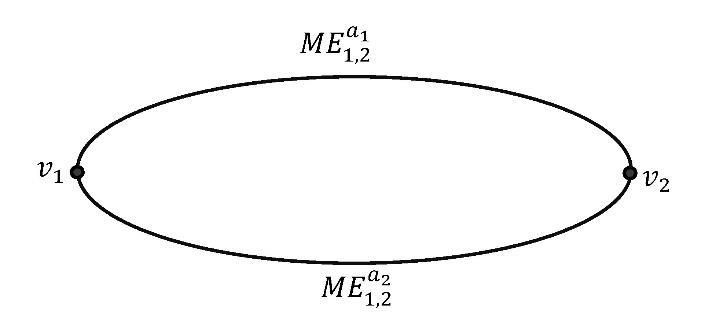
4 minute read
n-SuperHyperGraph and Plithogenic n-SuperHyperGraph
We introduce now for the first time the n-
Advertisement
SuperHyperGraph (n-SHG), n-SHG-vertex, and n-
SHG-edge, also the Plithogenic n-SuperHyperGraph (n-PSHG). A n-SuperHyperGraph SHG is an ordered pair n-SHG = (Gn Pn(V), En Pn(V)), where Pn(V) is the n-power set of the set V, for integer n ≥ 1, defined as follows: Pn+1(V) = P(Pn(V)). Also:
(i) V = {v1, v2, .., vn} is a finite set of n ≥ 1 vertices. (ii) P(V) is the power set of V (all subset of V). Therefore, an SHG-vertex may be a single (classical) vertex, or a subset-vertex (a subset of many vertices) that represents a group (organization), or even an indeterminatevertex (unclear, unknown vertex). (iii) E = {E1, E2, …, Em}, for m ≥ 1, is a family of subsets of V, and each Ej is an SHG-edge. An SHG-edge may be a (classical) edge, or a subset-edge (edge between subset-vertices) that represents connections between two groups (organizations), or hyper-subsetedge) that represents connections between three or more groups (organizations), multi-
107
edges, or even an indeterminate-edge (unclear, unknown edge).
Therefore, the n-SuperHyperGraph n-SHG may have any of the below: - Single-vertices (vi), as in classical graphs, such as: v1, v2, etc.; - SuperVertices (or Subset-vertices) (svi), belonging to P(V), for example: sv1,3 = v1v3, sv2,5,7 = v2v5v7, etc. that we introduce now for the first time. A subset-vertex may represent a group (organization, team, club, city, country, etc.) of many individuals - Indeterminate-vertices (i.e. unclear, unknown vertices); we denote them as: Iv1, Iv2, etc. that we introduce now for the first time; - Simple-edges, as in classical graphs, i.e. edges connecting only two single-vertices, for example: E1,5 = {v1, v5}, E2,3 = {v2, v3}, etc.; - HyperEdges, i.e. edges connecting three or more single-vertices, for example HE1,4,6 = {v1, v4, v6},
HE2,4,5,7,8,9 = {v2, v4, v5, v7, v8, v9}, etc. as in hypergraphs; - SubsetEdges, i.e. edges connecting only two vertices (and at least one vertex is subset-vertex), for example SE136,4579 = {v136, v4579} connecting two subset-vertices, SE9,2345 = {v9, v2345} connecting one
108
single-vertex with one subset-vertex, etc. that we introduce now for the first time; - HyperSubsetEdges, i.e. edges connecting three or more vertices (and at least one vertex is subsetvertex, for example HSE3,45,236 = {v3, v45, v236},
HSE1234,456789,567,5679 = {v1234, v456789, v567, v5679}, etc. that we introduce now for the first time; - MultiEdges, i.e. two or more edges connecting the same (single-/subset-/indeterminate-) vertices; each vertex is characterized by many attribute values, thus with respect to each attribute value there is an edge, the more attribute values the more edges (= multiedge) between the same vertices; - IndeterminateEdges (i.e. unclear, unknown edges; either we do not know their value, or we do not know what vertices they might connect): IE1, IE2, etc. that we introduce now for the first time.
Examples of 2-SuperHyperGraph, SingleEdge, and
MultiEdges
109
Figure 1. 2-SuperHyperGraph
Let v1 and v2 be two single-vertices, characterized by the attributes a1 = size, whose attribute values are {short, medium, long}, and a2 = color, whose attribute values are {red, yellow}. Thus we have the attributes values ( Size{short, medium, long}, Color{red, yellow} ), whence: v1(a1{s1, m1, l1}, a2{r1, y1}), where s1 is the degree of short, m1 degree of medium, l1 degree of long, while r1 is the degree of red and y1 is the degree of yellow of the vertex v1. And similarly v2(a1{s2, m2, l2}, a2{r2, y2}). The degrees may be fuzzy, neutrosophic etc.
110
Example of fuzzy degree: v1( a1{0.8, 0.2, 0.1}, a2{0.3, 0.5} ). Example of neutrosophic degree: v1( a1{ (0.7,0.3,0.0), (0.4,0.2,0.1),(0.3,0.1,0.1) }, a2{ (0.5,0.1,0.3), (0.0,0.2,0.7) } ).

Figure 2. SingleEdge with respect with both attributes a1 and a2

Figure 4. MultiEdge (= Refined-SingleEdge), top edge with respect to attribute a1,
bottom edge with respect to attribute a2
111

Figure 4. MultiEdge (= Refined RefinedSingleEdge), one edge for each of the attributes’ values.
Depending on the application and on experts, one chooses amongst single-edge, refined-single-edge, or refined refined-single-edge, etc. *
As a consequence, we introduce now for the first time the
Plithogenic n-SuperHyperGraph. A Plithogenic n-SuperHyperGraph (PSHG) is a n-
SuperHyperGraph whose each n-SHG-vertex and each n-SHG-edge are characterized by many distinct attributes values (a1, a2, …, ap, p ≥ 1). Therefore, one gets n-SHG-vertex(a1, a2, …, ap) and n-SHGedge(a1, a2, …, ap). The attributes values degrees of appurtenance to the graph may have crisp / fuzzy / intuitionistic fuzzy /
112
picture fuzzy / spherical fuzzy / neutrosophic / etc. / degrees with respect to each n-SHG-vertex and each n-
SHG-edge respectively. For example, one may have: Fuzzy-n-SHG-vertex(a1(t1), a2(t2), …, ap(tp)) and Fuzzy-n-
SHG-edge(a1(t1), a2(t2), …, ap(tp)); Intuitionistic Fuzzy-n-SHG-vertex(a1(t1, f1), a2(t2, f2), …, ap(tp, fp)) and Intuitionistic Fuzzy-n-SHG-edge(a1(t1, f1), a2(t2, f2), …, ap(tp, fp)); Neutrosophic-n-SHG-vertex(a1(t1, i1, f1), a2(t2, i2, f2), …, ap(tp, ip, fp)) and Neutrosophic-n-SHG-edge(a1(t1, i1, f1), a2(t2, i2, f2), …, ap(tp, ip, fp)); etc. Whence we get: The Plithogenic ( Crisp / Fuzzy / Intuitionistic Fuzzy /
Picture Fuzzy / Spherical Fuzzy / etc. / Neutrosophic /
Refined Neutrosophic ) n-SuperHyperGraph.
113


